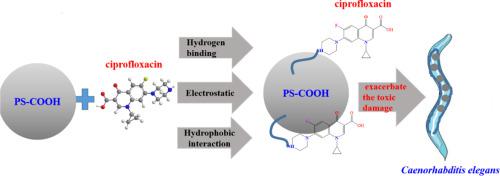Science of the Total Environment ( IF 9.8 ) Pub Date : 2020-09-16 , DOI: 10.1016/j.scitotenv.2020.142370 Mihebai Yilimulati 1 , Longfei Wang 2 , Xiaoli Ma 1 , Chuanwang Yang 3 , Nuzahat Habibul 1

|
Plastic debris is ubiquitous in aquatic systems and has been proven vehicles for the transport of various pollutants including trace organic compounds. Nanoplastics have large specific surface area and hydrophobic characteristics and therefore are capable of adsorbing other organic or inorganic chemicals from the environment. Antibiotics, as another class of emerging contaminants, have raised significant research concern in recent years as they pose threats to the ecosytems and human health. Nevertheless, little information is available on the adsorption behaviors of antibiotics onto nano-sized plastics. The toxicity of combined nanoplastics and antibiotics is also largely unknown. In this study, the physicochemical and thermodynamic interactions between representative nanoplastics, which containing a carboxyl functional group of polystyrene nanoplastics (PS-COOH), and typical antibiotic, i.e., ciprofloxacin (CIP) were investigated in a batch adsorption experiment. The specific thermodynamic correlation function of PS-COOH combined with CIP was obtained through isothermal titration microcalorimetry (ITC) analysis. The adsorption kinetics and isotherm of CIP on PS-COOH closely fit the pseudo-second-order kinetic model (r2 = 0.99) and Freundlich isotherm (r2 = 0.99). The ITC results showed that the adsorption reaction of PS-COOH with CIP was a spontaneous exothermic reaction. The adsorption of antibiotics on nanoplastics may aggravate the negative impacts of these two pollutants on aqueous ecosystems, and we hypothesized that would be reflected in the survival rate of model organism of Caenorhabditis elegans when exposed to this combination. This work used a mechanistic approach to unravel the adsorption behavior of antibiotics on nanoplastics and shed light on their potential impact on aquatic ecosystems.
中文翻译:

环丙沙星对功能化纳米聚苯乙烯塑料的吸附:动力学、热化学和毒性
塑料碎片在水生系统中无处不在,并且已被证明可用于运输各种污染物,包括微量有机化合物。纳米塑料具有较大的比表面积和疏水特性,因此能够从环境中吸附其他有机或无机化学物质。抗生素作为另一类新兴污染物,由于对生态系统和人类健康构成威胁,近年来引起了广泛的研究关注。然而,关于抗生素在纳米塑料上的吸附行为的信息很少。纳米塑料和抗生素组合的毒性在很大程度上也是未知的。在这项研究中,代表性纳米塑料之间的物理化学和热力学相互作用,在批量吸附实验中研究了含有羧基官能团的聚苯乙烯纳米塑料(PS-COOH)和典型的抗生素环丙沙星(CIP)。通过等温滴定微量热法 (ITC) 分析得到 PS-COOH 与 CIP 结合的特定热力学相关函数。CIP在PS-COOH上的吸附动力学和等温线非常符合准二级动力学模型(r 2 = 0.99) 和 Freundlich 等温线 ( r 2 = 0.99)。ITC结果表明PS-COOH与CIP的吸附反应是自发的放热反应。抗生素在纳米塑料上的吸附可能会加剧这两种污染物对水生态系统的负面影响,我们假设这将反映在秀丽隐杆线虫模式生物暴露于这种组合时的存活率上。这项工作使用一种机械方法来揭示抗生素在纳米塑料上的吸附行为,并阐明它们对水生生态系统的潜在影响。

























 京公网安备 11010802027423号
京公网安备 11010802027423号